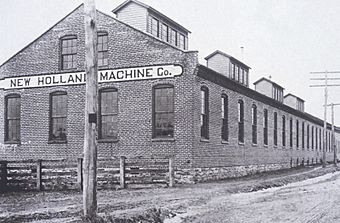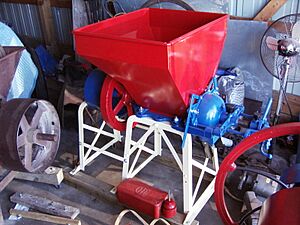New Holland Machine Company facts for kids
Quick facts for kids |
|
|
New Holland Machine Company
|
|

New Holland Machine Company building, c. 1895
|
|
| Location | 146 E. Franklin St., New Holland, Pennsylvania, U.S. |
|---|---|
| Area | 1.7 acres (0.69 ha) |
| NRHP reference No. | 00000846 |
| Added to NRHP | August 9, 2000 |
- This is a historical article. For current information see New Holland Ag
The New Holland Machine Company started in 1895. A young American named Abram Zimmerman bought a horse barn in New Holland, Pennsylvania. He opened a blacksmith shop there. Abram Zimmerman was very good with machines. He used his skills to fix and build farm equipment for local farmers.
Contents
The Historic Building: A Look Back
The New Holland Machine Company building is at 146 E. Franklin St. in New Holland. It was built in eight parts between 1903 and 1952. This two-story brick building has an interesting, changing shape. It was used for making industrial machines. The factory closed its doors in 1992. In 2000, it was added to the National Register of Historic Places. This means it is an important historical site.
Early Engines: Otto and Columbus
Abram Zimmerman began selling German Otto four-cycle engines. These were single-cylinder engines with two flywheels. They were made in Philadelphia. After a short time, Abe switched to selling another engine. It was called the Columbus. Selling these engines helped his blacksmith shop earn more money. By 1896, Zimmerman's shop had three employees. But Zimmerman always had new ideas.
The "Freeze-Proof" Engine Idea
Zimmerman believed he could build a better engine. He wanted one that was lighter and easier to fix. By 1900, he had designed his own engine. He even built early versions of it.
How Water Kept Engines Cool
Most engines back then used water to stay cool. A jacket around the engine cylinder was filled with water. This water kept the engine from getting too hot. Usually, the water would evaporate as the engine ran. Farmers had to keep adding more water throughout the day.
The Problem of Freezing Water
In winter, farmers had to drain the water from the engine jacket. If they didn't, the water would freeze. When water freezes, it expands. This expansion could crack the cast iron engine.
Zimmerman's Smart Solution
Zimmerman's new engine had a special water jacket. It was shaped like a bowl, wider at the top. If water froze in this bowl-shaped jacket, the ice could expand upwards. This meant it wouldn't crack the engine parts. Because of this clever design, Zimmerman's new engine was "freeze-proof."
Starting the New Holland Company
With his new engine ready, Zimmerman wanted to make and sell it. He needed to form a company and get investors. So, Zimmerman raised $50,000. He sold 500 shares of his new company to his neighbors. This is how the New Holland Machine Company officially started in 1903.
Zimmerman became the chief executive of the new company. With the new money, the company bought a brick factory. This factory was on Franklin Street in New Holland. They hired 40 employees to build the new engines.
Different Engine Sizes
The New Holland Company eventually made six different sizes of its engine. These ranged from a small ½ horsepower (hp) engine to a 5 hp model. The 5 hp model was the most popular. By 1911, sales of the 5 hp engine had grown by over 253% since 1904.
The engine sizes were:
- ½ HP
- 1 ½ HP
- 2 HP
- 3 HP
- 4 HP
- 5 HP
Growing the Business
The company was successful from the start. In its first yearly report in 1904, it showed profits of $1,859.40. Selling engines led the New Holland Machine Company to make other farm products.
The Feed Grinder Invention
Even before the company officially started, Abe Zimmerman's blacksmith shop advertised a feed grinder. This machine could grind 10 to 30 bushels of feed per hour. It was sold to farmers for $15.00.
Later, the New Holland Machine Company sold these feed grinders with options. Farmers could get them mounted on a wooden or steel cart. They could also have one of the larger New Holland engines (4 hp to 16 hp) attached. This made the grinder and engine a single unit. It could be easily moved around the farm.
New Machines: Rock Crusher and Wood Saw
After the company was formed, more machines were added. In 1912, they started making their own rock crusher. By 1914, the New Holland Machine Company also made a wood saw. By 1911, the company had 150 employees. By 1927, this number grew to 225.
Joining Sperry Corporation
The New Holland Machine Company was bought by the Sperry Corporation in 1947. It then became Sperry-New Holland. To learn more about what happened next, you can look up New Holland Agriculture.




